 Many academics and commentators on American foreign policy have maintained that since the end of the Vietnam and Cold Wars, foreign policy-making has become subject to the kind of partisan political battles that have long afflicted domestic politics. By using data on over 1,000 individual appointees to the U.S. foreign policy bureaucracy Michael Flynn tests this view, and finds that there is no evidence to support the idea that bipartisanship in appointments has undergone a structural shift. He argues that domestic political conditions play an important part in promoting bipartisanship, and that as Congress has become more polarized, bipartisan appointments have become increasingly scarce. He warns that we should expect to see less bipartisan cooperation through presidential appointments in the future.
Many academics and commentators on American foreign policy have maintained that since the end of the Vietnam and Cold Wars, foreign policy-making has become subject to the kind of partisan political battles that have long afflicted domestic politics. By using data on over 1,000 individual appointees to the U.S. foreign policy bureaucracy Michael Flynn tests this view, and finds that there is no evidence to support the idea that bipartisanship in appointments has undergone a structural shift. He argues that domestic political conditions play an important part in promoting bipartisanship, and that as Congress has become more polarized, bipartisan appointments have become increasingly scarce. He warns that we should expect to see less bipartisan cooperation through presidential appointments in the future.
The idea that foreign policy and national security issues are somehow exempt from the partisan rancor that often characterizes domestic politics is perhaps best encapsulated by the old adage, “politics stops at the water’s edge.” In American foreign policy, nowhere is this spirit better exemplified than by President Franklin Roosevelt’s appointment of Henry L. Stimson as Secretary of War. Since World War II, Stimson and other prominent bureaucratic appointees—such as Robert Lovett and John McCloy—have come to represent this ideal. This phenomenon of bipartisan cooperation that is held to have characterized the early Cold War period has been popularly referred to as the “Cold War Consensus”, or as “Establishment” bipartisanship.
However, following the Vietnam War pronouncements of the collapse of this bipartisan consensus became commonplace. Similar claims followed the end of the Cold War, and more recently, the terrorist attacks of September 11, 2001. Indeed, such assertions have become common in discussions of American foreign policy, with the broader substantive implication being that the conduct of American foreign policy has become increasingly erratic and subject to the kind of partisan political battles that have long afflicted domestic politics.
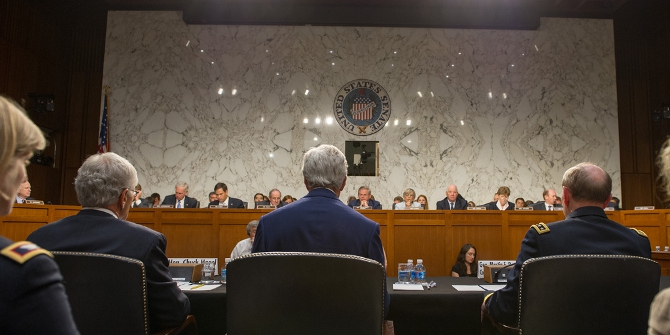
Some of my recent work evaluates just how closely these stylized truths match up with reality. Earlier accounts of the breakdown of bipartisanship in foreign policymaking relied largely on anecdotal accounts or individual’s assertions with little in the way of systematic evidence (see here, here, and here). Some work by political scientists has done better in approaching the concepts of bipartisanship and consensus in a more systematic way (see here, here, here, and here). Still, there are some gaps that my work tries to address. First, earlier qualitative works often focused on elite bureaucratic policymakers (like Stimson), while quantitative studies have tended to focus on congressional voting patterns or public opinion. Second, foreign policy scholars often view bipartisan cooperation through the lens of foreign threats and crises, ignoring or downplaying more basic domestic political pressures that may drive bipartisanship. My work aims to apply a more systematic form of analysis to the subject of bipartisanship in presidential appointments, while also assessing the relative importance of domestic and international factors in affecting bipartisan cooperation.
Using data on over 1,000 individual appointees to the foreign policy bureaucracy—agencies like the State Department and the Department of Defense—I identified those individual appointees who were members of the opposition party (e.g., Republican serving in a Democratic administration). Figure 1 shows the number of bipartisan appointees in a given year between 1948 and 2011. While this is only a starting point, it does not lend much support to the conventional narrative regarding the apparent collapse of bipartisanship following either Vietnam or the end of the Cold War. In fact, the early Cold War period sees some of the lowest counts observed in the data.
Figure 1 — Annual count of bipartisan appointees, 1948–2011
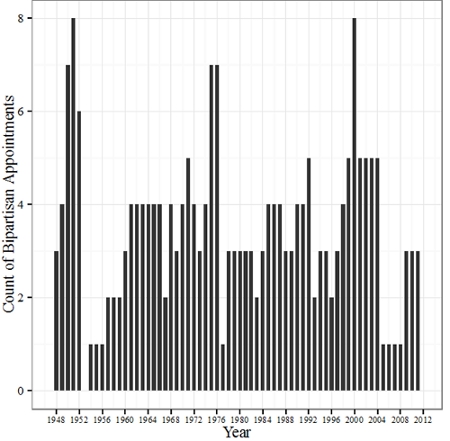
However, Figure 1 does not provide us with any insights into the effects of a wider range of variables that might be influencing bipartisanship. Accordingly, I modeled the probability of observing a bipartisan appointment in a given year as a function of these different forces. Briefly stated, I find no evidence to support the idea that bipartisanship has undergone a structural shift following either Vietnam or the end of the Cold War. In fact, as is displayed in Figure 2, each party’s probability of making a bipartisan appointment has converged when comparing the pre- and post-Vietnam periods. Though it may be contrary to our expectations, this finding makes sense when we consider the domestic political environment of the early Cold War period. The McCarthy hearings, as well as the long absence of Republicans from the White House, help to explain the scarcity of bipartisan appointments during some of the early Cold War years.
Figure 2 — Predicted probability of a bipartisan appointment by party and time period
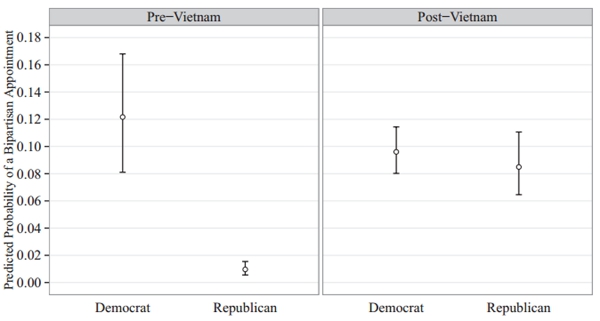
Similarly, I find no evidence that US conflict involvement promotes bipartisanship. On the contrary, my findings indicate conflict involvement actually has a negative effect on bipartisanship. As Figure 3 shows, the predicted probability of observing a bipartisan appointment decreases as the duration of US war involvement increases. Furthermore, these results actually match the findings of previous studies. Using different metrics, an earlier study by Peter Trubowitz and Nicole Mellow also finds a negative correlation between international crises and bipartisanship in Congressional voting. This negative relationships is likely due to the increasingly contentious and politicized nature of particularly long military engagements.
Figure 4 — Predicted probability of a bipartisan appointment as a function of war duration
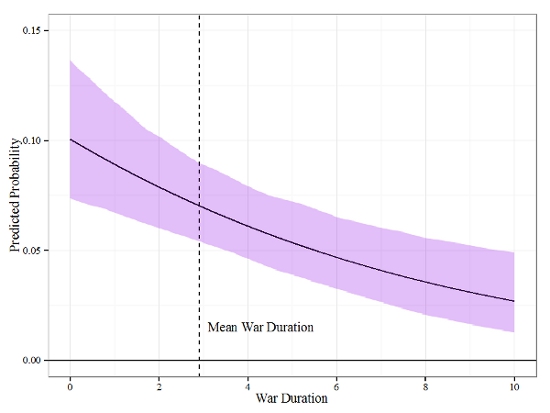
Lastly, I find that domestic political conditions play an important part in promoting bipartisanship. I argue that bipartisan appointments can serve to compensate presidents for lower levels of partisan support in Congress and aid in the construction of moderate coalitions. However, this dynamic only works when the parties are close and there are moderate legislators in Congress with whom the president and his appointees can work. But as the parties in Congress have become more polarized, moderate legislators have become increasingly scarce. Figure 4 illustrates this dynamic. At low levels of polarization, a decrease in the number of seats that the president’s party controls in Congress leads to an increase in the probability of seeing a bipartisan appointment. As polarization increases the size of this effect becomes smaller, eventually becoming negative.
Figure 5 — Marginal effect of a decrease in presidential support in Congress on the probability of a bipartisan appointment
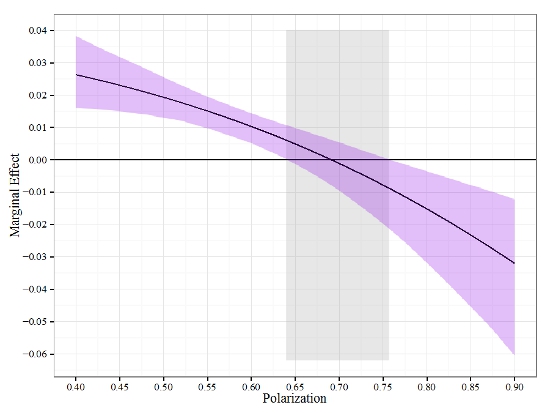
Note: Gray box denotes area of statistical insignificance.
Overall, these findings cast doubt on some of the conventional wisdoms surrounding American foreign policy, pointing instead to the importance of the domestic political environment in promoting bipartisanship. Accordingly, my research suggests that we should expect to see less bipartisan cooperation through presidential appointments moving forward. The fact that polarization unfolds over several years at a time also suggests that this trend is unlikely to reverse itself any time soon. President Obama’s retention of Robert Gates, and his appointment of Chuck Hagel as Secretary of Defense, would seem to provide some evidence to the contrary. However, while these appointments are surely important, they are not necessarily indicative of broader trends.
This article is based on the paper The International and Domestic Sources of Bipartisanship in U.S. Foreign Policy, in Political Research Quarterly.
Please read our comments policy before commenting.
Note: This article gives the views of the authors, and not the position of USApp– American Politics and Policy, nor of the London School of Economics.
Shortened URL for this post: http://bit.ly/1gyFjnF
_________________________________
 Michael Flynn – University of Alabama
Michael Flynn – University of Alabama
Michael Flynn is currently a postdoctoral fellow in the Department of Political Science at the University of Alabama. Beginning in the fall of 2014 he will be joining the Department of Political Science at Kansas State University as an assistant professor. His research focuses on the political and economic determinants of foreign economic and security policy. His research also focuses on the influence of non-state actors and how they affect states’ policy choices, particularly with respect to human rights issues.




1 Comments